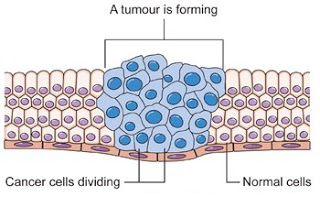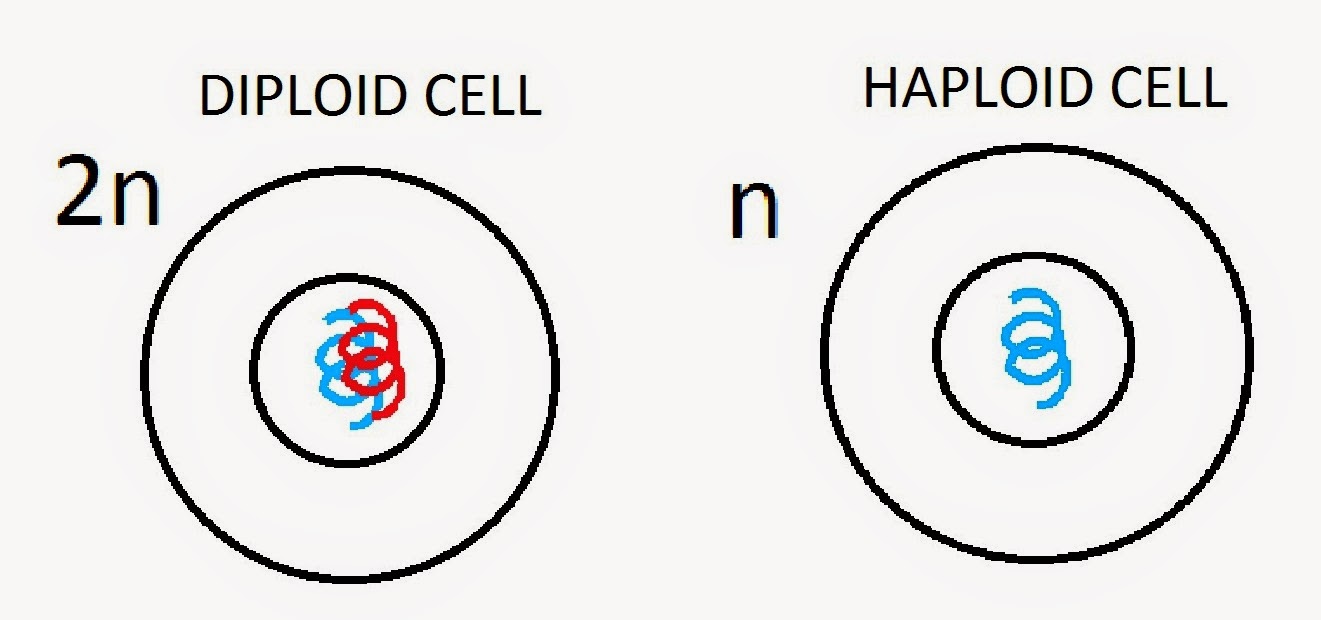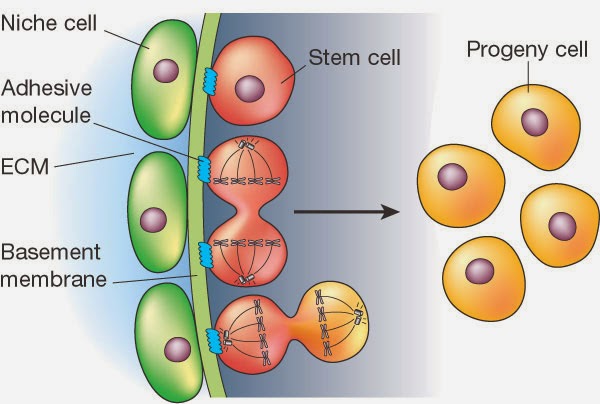Biology
 Each cell contains genes that help to control when it divides.
Each cell contains genes that help to control when it divides.
Cells divide by mitosis only when required.
When receives signals from neighbouring cells, it responds by dividing or not dividing.
- Notes On Reproduction
Some key points about mitosis and meiosis.Mitosis· Mitosis is where diploid cells produce more diploid cells. This is how all the cells are reproduced, except, the gametes ( sex cells) · ...
- Meiosis
This produces sex cells i.e. sperm and eggs. The sex cells (gametes) have half the number (haploid) of chromosomes, so that when fertilisation occurs the fertised egg has the full compliment of chromosomes (diploid). Look at the following sequence, which...
- Haploid Chromosome Number
For humans the haploid number of chromosomes is 23 because their diploid number is 46; haploid is the half of diploid. For humans only their gametes, or sex cells, are haploid. Haploid means that a particular cell has only one member of each homologous...
- #32 Summary Of Cell And Nuclear Division
1. Growth of a multicellular organism is a result of parent cells dividing to produce genetically identical daughter cells. 2. During cell division the nucleus divides first, followed by division of the whole cell. 3. Division of a nucleus to produce...
- # 28.2 The Mitotic Cell Cycle - Syllabus 2016
5.1 Replication and division of nuclei and cells 5.2 Chromosome behaviour in mitosis When body cells reach a certain size they divide into two. Nuclear division occurs first, followed by division of the cytoplasm. The mitotic...
Biology
#31 Control of cell division, Stem cell, Haploid and Diploid cells
 Each cell contains genes that help to control when it divides.
Each cell contains genes that help to control when it divides.Cells divide by mitosis only when required.
When receives signals from neighbouring cells, it responds by dividing or not dividing.
If this control goes wrong, cells may not divide when they should (growth does not take place, or wounds do not heal) or they may divide when they should not (a tumour may form).
1. Cancer and uncontroled cell division
2. Significance of mitosis in cell replacement and tissue repair by stem cells
3. Haploid and Diploid cells


1. Cancer and uncontroled cell division
- In cancer: genes that control cell division mutate --> cell divide over and over again, forming an irregular mass of cells.
- In malignant tumour: some of cancer cells may break off and start to form new tumours elsewhere in the body.
- Several genes must mutate before a cell becomes cancerous. This can happen just by chance.
- The risk is increased by factors that cause mutation (carcinogenic factors):
- ultraviolet radiation (in sunlight)
- chemicals (e.g. asbestos, some component in tar from tobacco smoke)
- viruses (e.g. human papilloma virus - HPV, causing cervical cancer).
- viruses (e.g. human papilloma virus - HPV, causing cervical cancer).
2. Significance of mitosis in cell replacement and tissue repair by stem cells
- Stem cells are undifferentiated biological cells that can differentiate into specialized cells and can divide to produce more stem cells.
- They are present both during embryonic development (embryonic stem cells) and in the adult body (adult stem cells).
- In adult organisms, stem cells act as a repair system for the body, replenishing adult tissues.
- They divide by mitosis to form either two stem cells, thus increasing the size of the stem cell "pool", or one daughter that goes on to differentiate, and one daughter that retains its stem-cell properties.
 |
| Niche cells (green) underlying a basement membrane signal to stem cells (red) to block differentiation and regulate division. The stem cell divides such that one daughter retains its connections to the niche, while the other (yellow) becomes untethered (released) and begins to differentiate. Source: nature.com |

Haploid cells
- Haploid cells are cells that contain only 1 complete set of chromosomes. The most common type of haploid cells is gametes, or sex cells.
- Haploid cells are produced from diploid cells by meiosis (each daughter cell gets only half of the original number of chromosomes).
- In human, when the sperm and egg (haploid celss with 1 set of 23 chromosomes) fused together, this produced a diploid zygote with 2 sets of chromosomes (46 chromosomes). As this cell divided by mitosis, each daughter cell obtained a complete copy of each set.

Diploid cells
- Most of the cells in the body are diploid cells, they contain 2 complet sets of chromosomes, 1 from mother and one from father. Each cell has 46 chromosomes.
- Diploid cells reproduce using mitosis, which creates a completely identical copy of the cell.
- Meiosis help to produce haploid cells from diploid cells (it is a reduction division, because it reduces the number of chromosomes in a cell by half). Meiosis must take place at some point in the life cycle before fertilisation. In humans, it only happens in the testes and ovaries.
| Syllabus 2015 (d) explain how uncontrolled cell division can result in the formation of a tumour and identify factors that can increase the chances of cancerous growth; (e) explain the meanings of the terms haploid and diploid (see section 5) and the need for a reduction division (meiosis) prior to fertilisation in sexual reproduction (note: descriptions of homologous chromosomes are not required for AS Level); |
Syllabus 2016 e) outline the significance of mitosis in cell replacement and tissue repair by stem cells and state that uncontrolled cell division can result in the formation of a tumour |
- Notes On Reproduction
Some key points about mitosis and meiosis.Mitosis· Mitosis is where diploid cells produce more diploid cells. This is how all the cells are reproduced, except, the gametes ( sex cells) · ...
- Meiosis
This produces sex cells i.e. sperm and eggs. The sex cells (gametes) have half the number (haploid) of chromosomes, so that when fertilisation occurs the fertised egg has the full compliment of chromosomes (diploid). Look at the following sequence, which...
- Haploid Chromosome Number
For humans the haploid number of chromosomes is 23 because their diploid number is 46; haploid is the half of diploid. For humans only their gametes, or sex cells, are haploid. Haploid means that a particular cell has only one member of each homologous...
- #32 Summary Of Cell And Nuclear Division
1. Growth of a multicellular organism is a result of parent cells dividing to produce genetically identical daughter cells. 2. During cell division the nucleus divides first, followed by division of the whole cell. 3. Division of a nucleus to produce...
- # 28.2 The Mitotic Cell Cycle - Syllabus 2016
5.1 Replication and division of nuclei and cells 5.2 Chromosome behaviour in mitosis When body cells reach a certain size they divide into two. Nuclear division occurs first, followed by division of the cytoplasm. The mitotic...
